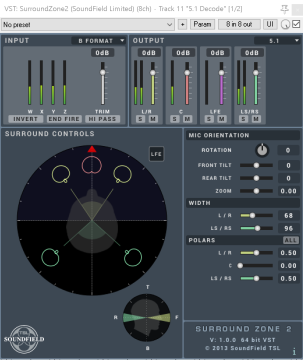On 24th and 25th November 2017 I had the great pleasure of recording Ramsbottom Choral Society and Orchestra during their final rehearsal, then concert performance of Handel’s Messiah. Having used surround microphone positioning (Rode NT4, Rode NT2-A, 2 x AKG C214) and the SoundField ST450 microphone, I decided to take a short piece from the recordings to create an ambisonic and binaural mix.
The surround microphone setup was recorded into a laptop running Avid Pro Tools, while the SoundField ST450 was recorded into a Zoom F4 field recorder. The recorded audio was to be synchronised later.

The Zoom F4 was ideal to capture the first order B-format W,X,Y and Z audio channels from the SoundField ST450. These B-format audio recordings were decoded using the free SoundField SurroundZone2 plugin within Reaper. This plugin can be used to decode any B-format audio, not restricted to audio recorded using SoundField products. Below is a screenshot of the decoded 5.1 positioning using the SoundField SurroundZone2 plugin.

Having decoded the SoundField ST450 recordings to 5.1, I needed to position the other microphones recordings within the mix. I have been using the ambiX ambisonic plugin suite for a while and would like to demonstrate some of its’ uses. The ambiX suite uses convolution of head related transfer function (HRTF) databases and loudspeaker impulse responses (IR) to create ambisonic and 360 audio content. It is also possible to use the ambiX suite with HRTF databases or IR presets created by yourself. This is something I am exploring further, but I need to understand MatLab in more detail. If you are interested in creating your own databases the AES69-2015 standard is a good read.
Using the Binaural Decoder within the ambiX suite, I was able to simulate 12 virtual loudspeakers in a dodecahedron array. The screenshot below shows the pan positions of the five microphones used.

The AmbiX Encoder is a spherical panner. The Rode NT4 was positioned high above the conductor’s head when recording, so I have positioned it with left/right at -/+ 90 degrees azimuth with 60 degrees of elevation to give some stereo height within the mix. The Rode NT2-A mono mic was also high and behind the conductor, so is central with 75 degrees of elevation. The pair of AKG C214 were stereo room mics and have been positioned accordingly within the mix.
I did experiment with using higher order ambisonics and more virtual loudspeakers (up to 50), however due to the natural room reverb within the open recordings, it causes phase issues during convolution with the impulse responses.
If you would like to listen to the audio, please click below (headphones required):

